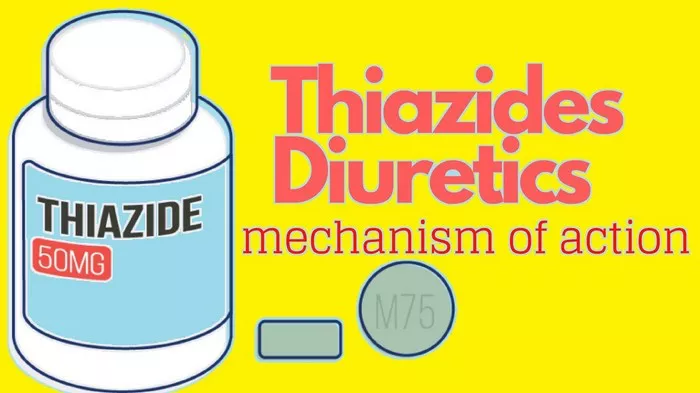Thiazide diuretics are commonly prescribed medications for managing hypertension and various other cardiovascular conditions. However, one of the notable side effects associated with thiazides is hyperlipidemia, characterized by elevated levels of lipids in the bloodstream. Understanding why thiazides induce hyperlipidemia requires delving into their pharmacological mechanisms and their impact on lipid metabolism. This article explores the intricate relationship between thiazide diuretics and hyperlipidemia, shedding light on the underlying mechanisms and clinical implications.
Thiazide Diuretics: Mechanism of Action
Thiazide diuretics, such as hydrochlorothiazide (HCTZ), chlorthalidone, and indapamide, are widely used for their antihypertensive effects. They primarily act on the distal convoluted tubule of the nephron in the kidneys, inhibiting the sodium-chloride symporter (NCC). By blocking this transporter, thiazides reduce sodium reabsorption, leading to increased excretion of sodium and water, thus lowering blood pressure.
Lipid Metabolism and Regulation
Before delving into how thiazides influence lipid levels, it’s crucial to understand the basics of lipid metabolism. Lipids play vital roles in the body, serving as energy sources, structural components of cell membranes, and precursors to hormones. The major classes of lipids include triglycerides (TGs), cholesterol, and phospholipids.
1. Triglycerides (TGs): TGs are the most abundant form of dietary fats and serve as a storage form of energy in adipose tissue. They consist of glycerol and three fatty acid chains.
2. Cholesterol: Cholesterol is a crucial component of cell membranes and serves as a precursor for steroid hormones, bile acids, and vitamin D. It exists in various forms, including low-density lipoprotein (LDL) and high-density lipoprotein (HDL).
3. Phospholipids: Phospholipids are essential for cell membrane structure and function. They have a hydrophilic head and hydrophobic tails, contributing to the formation of lipid bilayers.
Lipid metabolism is tightly regulated by various enzymes, transport proteins, and hormonal signals. Key players in lipid regulation include lipoproteins (e.g., LDL, HDL), lipases (e.g., lipoprotein lipase), and transcription factors (e.g., sterol regulatory element-binding proteins, SREBPs).
Thiazides and Hyperlipidemia: The Connection
While thiazide diuretics are effective in lowering blood pressure, they can also lead to adverse metabolic effects, including hyperlipidemia. The mechanisms underlying thiazide-induced hyperlipidemia are multifactorial and involve alterations in lipid synthesis, transport, and metabolism.
1. Effect on Lipid Synthesis: Thiazides have been shown to increase the synthesis of fatty acids and triglycerides in the liver. This occurs partly due to the activation of sterol regulatory element-binding proteins (SREBPs), transcription factors that regulate genes involved in lipid synthesis. Elevated SREBP activity leads to upregulation of enzymes such as fatty acid synthase (FAS) and acetyl-CoA carboxylase (ACC), promoting fatty acid and triglyceride production.
2. Insulin Sensitivity and Glucose Metabolism: Thiazides can also affect insulin sensitivity and glucose metabolism, which indirectly influence lipid levels. They may impair insulin sensitivity in peripheral tissues, leading to hyperinsulinemia and increased lipogenesis. Additionally, thiazides can elevate blood glucose levels, especially in individuals with predisposing factors such as diabetes or insulin resistance.
3. Altered Lipoprotein Profile: Thiazides can modify the distribution and composition of lipoproteins in the bloodstream. Studies have shown that thiazide use is associated with increased levels of total cholesterol, LDL cholesterol, and triglycerides, along with decreased levels of HDL cholesterol. These changes contribute to a less favorable lipid profile and may increase cardiovascular risk over time.
Clinical Implications and Management Strategies
The development of hyperlipidemia during thiazide therapy has important clinical implications, particularly in patients with preexisting cardiovascular risk factors. Healthcare providers must carefully weigh the benefits of thiazide treatment in blood pressure control against the potential metabolic side effects, including hyperlipidemia. Here are some key considerations and management strategies:
1. Baseline Lipid Assessment: Before initiating thiazide therapy, clinicians should obtain baseline lipid profiles to assess the patient’s lipid status. This baseline evaluation helps in monitoring lipid changes during treatment and identifying individuals at higher risk for developing hyperlipidemia.
2. Regular Monitoring: Patients receiving thiazide diuretics should undergo regular monitoring of lipid levels, ideally every 3 to 6 months or as clinically indicated. Monitoring allows for early detection of lipid abnormalities and facilitates timely interventions.
3. Lifestyle Modifications: Emphasizing lifestyle modifications remains a cornerstone in managing thiazide-induced hyperlipidemia. Encouraging patients to adopt a heart-healthy diet low in saturated fats and cholesterol, engage in regular physical activity, maintain a healthy weight, and avoid tobacco use can help mitigate lipid-related risks.
4. Consider Alternative Therapies: In cases where thiazides exacerbate hyperlipidemia or are contraindicated due to metabolic concerns, alternative antihypertensive medications may be considered. ACE inhibitors, angiotensin receptor blockers (ARBs), calcium channel blockers, and beta-blockers are among the options that have less impact on lipid profiles.
5. Combination Therapy: In some situations, combination therapy with thiazides and lipid-lowering agents such as statins or fibrates may be warranted. However, the decision to combine medications should be individualized based on the patient’s overall cardiovascular risk profile, comorbidities, and tolerability.
Conclusion
Thiazide diuretics are valuable medications for managing hypertension and reducing cardiovascular risk. However, their association with hyperlipidemia underscores the importance of vigilant monitoring and proactive management strategies. Healthcare providers should consider individual patient factors, including baseline lipid levels, cardiovascular risk profile, and comorbidities, when prescribing and monitoring thiazide therapy. By balancing the benefits of blood pressure control with the potential metabolic effects, clinicians can optimize patient outcomes and reduce cardiovascular morbidity and mortality.

